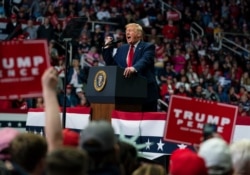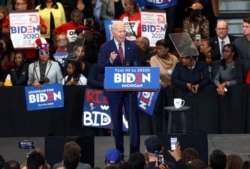President Donald Trump and his Democratic challenger, former Vice President Joe Biden, appear on track to break campaign fundraising records ahead of the Nov. 3 presidential election.
Although Trump had a significant head start in raising money for his reelection effort, Biden outraised Trump by $10 million in June, which marked the second consecutive month that the presumptive Democratic nominee took in more than the Republican president.
Campaign fundraising is a constant challenge facing candidates, their political parties and allied organizations, as the cost of campaigning increases every four years.
Here is a useful primer on presidential campaign finance:
How much do US presidential campaigns cost?
Presidential campaigns of both major political parties raise and spend hundreds of millions of dollars from the moment the eventual nominee announces he or she is running until the general election - a period that, in modern times, stretches well over a year. Total expenditures for presidential campaign cycles mushroomed more than 1,000% from 1980, when Ronald Reagan defeated Jimmy Carter, to 2012, when Barack Obama beat Mitt Romney. Election observers say the 2020 contest could prove to be the most expensive America has ever seen -- even with campaigning limitations due to the pandemic.
History of presidential campaign costs
Compared to the digital age, it cost the first U.S. president, George Washington, almost nothing to run for office in 1788-1789, when America was a much smaller nation and mass-communications were non-existent. Today, campaigns seek to engage more than 150 million registered voters on the internet and social media, the airwaves, in print and in person. Advertising across a cornucopia of media outlets and platforms consumes the biggest share of campaign funds. Campaign staff, field offices, polling and other research, public events and fundraising also require vast resources, even during a coronavirus pandemic when much campaign activity is done virtually. Spending by presidential campaigns, the political parties backing them and outside advocacy groups totaled $2.8 billion in 2008 and $2.4 billion in 2016, according to the Center for Responsive Politics, a Washington-based group that tracks money in politics.
Where does the money come from?
Presidential campaigns receive contributions directly from the people. Each American may give up to $2,800 per election. Upon securing the nomination, candidates often raise funds in larger amounts by working in tandem with their party’s national committee. Campaigns also benefit from political action committees (PACs), which operate independently to pool limitless funds for advertising in support of an electoral or legislative outcome. Political spending by businesses, often shielded from public scrutiny, increased markedly after 2010, when the Supreme Court held that the constitutional guarantee of free speech extends to political expenditures by corporations and labor unions.
Does more money guarantee victory?
In a word, no. Democrat Hillary Clinton outspent Trump by hundreds of millions of dollars in the 2016 campaign and lost. In 1996, Republican Bob Dole fell short despite spending more than then-President Bill Clinton. In 1984, Democrat Walter Mondale narrowly outspent then-Republican President Ronald Reagan and suffered one of the worst drubbings in U.S. presidential history. More often than not, however, having more money does correlate with victory on Election Day. From 2000 through 2012, Republican George W. Bush and Democrat Barack Obama each won two presidential contests with campaign war chests that exceeded those of their opponents.
Spending projections for 2020
The 2020 campaign total won’t be known until after the November election but already featured massive expenditures by two wealthy Democratic primary contenders who dropped out of the race, Tom Steyer and Michael Bloomberg. Currently both Biden and Trump are raising money at a prodigious pace – more than half a billion dollars combined in the three months ending June 30. Although Biden has edged Trump in fundraising in recent months, the president was believed to have more cash-on-hand heading into the general election cycle.
Impact of the pandemic, rise of social media
COVID-19 has not sapped campaign fundraising but is having a dramatic impact on how funds are spent. Trump has limited traditional live campaign events with supporters while Biden has foregone them completely. Shifts in how Americans consume news and information are apparent, as well. For the first time, 2020 could see presidential campaigns spend more on digital advertising than on television and radio. Biden outspent Trump on Facebook advertising in June and recently raised nearly $11 million in a digital grassroots fundraiser with former President Obama. Trump, meanwhile, remains a juggernaut on Twitter and other platforms, reaching massive audiences without spending a penny.






























